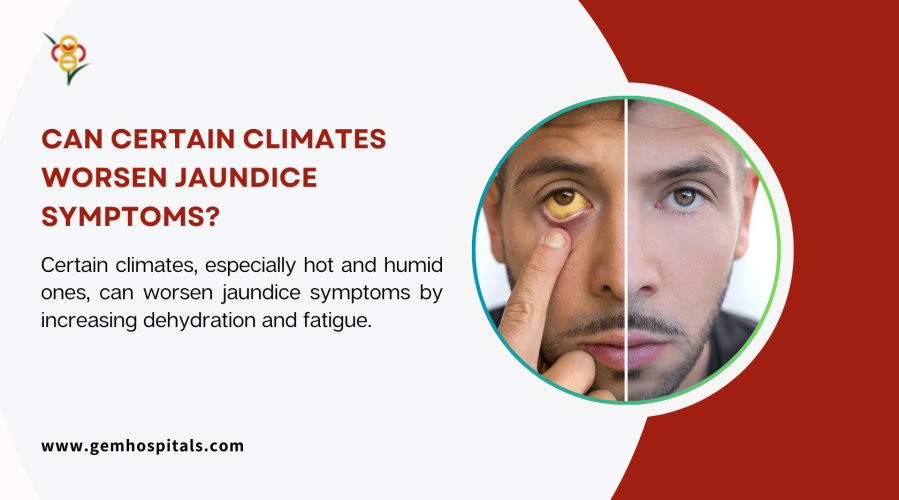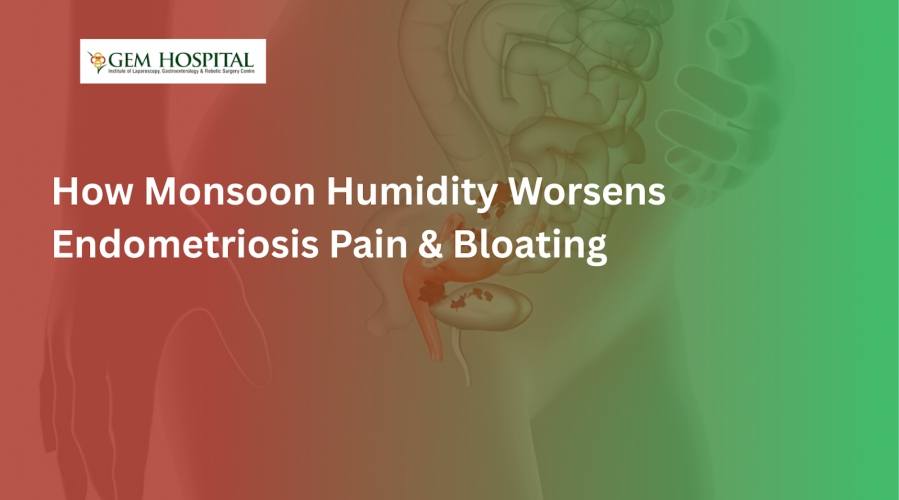Food poisoning is common during the monsoon. Learn when it becomes serious, how it can lead to pancreatitis or liver damage, warning signs, and when to seek medical care.
Can Certain Climates Worsen Jaundice Symptoms?

Jaundice is a condition that presents itself by yellowing of the skin and the eyes and is usually as a result of high bilirubin levels in the body, a result of liver problems. Even though jaundice is linked with internal sickness, external factors like climate can also affect the extent of ailment. In this blog, we will explore how some climates can exacerbate jaundice and what steps you can take to address symptoms depending on the weather.
Does Climate Have Any Real Impact on Jaundice Symptoms?
While climate does not in any way cause jaundice, it can somehow affect the manner in which the body handles the disease. In other words, external conditions such as heat or cold, humidity, or air quality can impact the liver, hydration, and even healing processes. Various climates such as hot, cold and humid climates are different and therefore require one to have different lifestyles when suffering from jaundice.
Practical Advice for Managing Jaundice in Different Climates
Hot Climates:
In hot and humid climate, the risk of dehydration is high in patients with jaundice. Dehydration is particularly a problem because the liver is already under pressure to flush out bilirubin and other toxins, and this can worsen.
Tips for Hot Climates:
- Take lots of water and other beverages that contain electrolytes.
- It is advisable not to go out in the sun during the hours when the intensity is high.
- Bring comfortable, loose and airy clothing to avoid overheating.
- Take water soluble fruits and vegetables such as cucumber and watermelon in your diet.
Cold Climates:
In cold weather, metabolism and immunity are usually lowered and this is a reason why jaundice takes longer to heal. Also, low light intensity and lack of movement during the cold season have adverse effects on physical health.
Tips for Cold Climates:
- Stay warm to keep your body temperature up and to avoid putting pressure on your liver.
- Exercise lightly to increase blood circulation and help the liver to work more effectively.
- Ensure that the body is taking the right vitamins and minerals that will help build the immune system.
Humid and Polluted Climates:
The influence of high humidity and poor quality air also affects the body in regaining the color of the skin when a person is sick of jaundice. High humidity level may lead to fatigue, air pollution may compromise the immunity, and thus facilitate the liver to work inefficiently.
Tips for Humid and Polluted Climates:
- Avoid going out during the time of high humidity and bad air quality.
- It is important to use air purifiers in order to have good quality of air inside the building.
- Take enough water and incorporate foods that are good for the liver into your diet.
How to Prevent Worsening Symptoms in Different Climates
Irrespective of the prevailing weather conditions whether it is hot or cold or hot and humid, there are ways in which we can avoid the worsening of jaundice symptoms. Drinking water is important at all times, although it is more important when the weather is hot and wet. Furthermore, incorporating foods that are beneficial to the liver into your meal plan and avoiding foods that are detrimental to the liver will greatly improve the liver’s ability to heal and function properly.
Here are some general tips for managing jaundice in different climates:
- Stay hydrated: Ensure you take enough water in a day and avoid drinks that make you dehydrated such as alcohol or caffeine.
- Eat a balanced diet: Avoid foods that harm the liver and take foods that are healthy for the liver such as fruits, vegetables and lean meats.
- Avoid extreme weather conditions: In other words, avoid going outside when it is very hot or very cold because this puts extra pressure on the liver.
Regions Where Jaundice Symptoms May Be Worse
Some of the areas with very hot or very cold climates may prove difficult to the patients with jaundice. For example:
- In regions where the temperatures are high and humidity is high, the chances of getting dehydrated are high and this poses a challenge to liver metabolism.
- Certain climatic conditions such as cold climate, long winter and short sunshine duration are likely to slow down recovery because of a weak immune system.
- Additional pollution in urban areas may also affect the liver in areas with high pollution intensities, including the quality of the air.
In these territories, it is crucial to adhere to the lifestyle changes that assist in controlling the symptoms of jaundice and seek medical advice.
Although climate does not lead to jaundice, it can affect the way that the body handles the disease. Environmental factors such as heat or cold, or even humidity can influence how you hydrate, how your liver works, and how you recover, so you need to modify your behaviour. Jaundice can be well managed by drinking plenty of fluids, avoiding foods that are unhealthy for the liver and avoiding extremely hot or cold weather.
So if you or any of your family members is suffering from jaundice, the best thing to do is consult your doctor. Jaundice treatment at GEM Hospital is personalized according to your condition and requirements so that you can get back to normal quickly. Book your appointment today.
Blogs & Article
UTI cases often rise during the rainy season. Learn why urology patients need extra precautions, common causes, symptoms, and prevention tips to stay healthy during monsoon.
Monsoon humidity can worsen endometriosis pain and bloating. Learn how weather changes affect symptoms and discover practical tips to manage discomfort during the rainy season.


